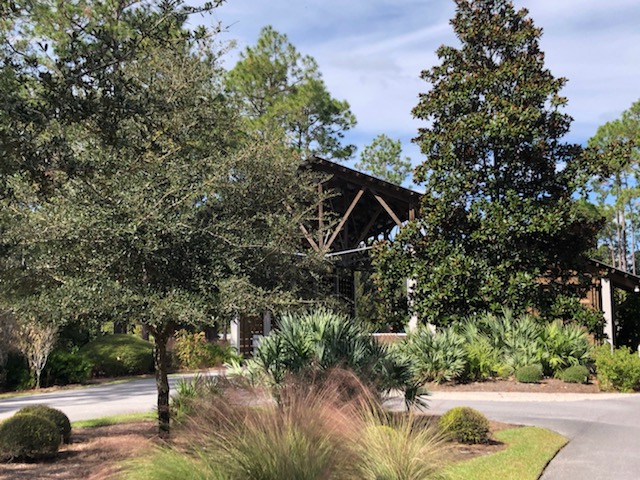
by Stephen Greer | Mar 11, 2021
Landscaping with native plants brings opportunities and challenges while adding diversity and beauty to the home. There are many factors that come into play to successfully grow plants. As gardeners, we all want things to look exceptional for all to enjoy. Native plants have evolved over long periods of time naturally in a given region without intervention, bringing much needed diversity to natural areas and landscapes. A big plus for natives are the flowers presented for the local bee populations and other pollinators assisting in the continuation of the plant species potentially established over thousands of years.
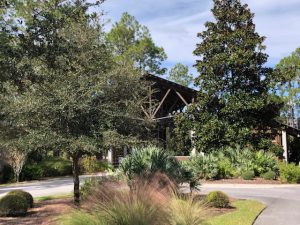
Landscape of Native Plants. Photo Credit: Stephen Greer, UF IFAS Extension Santa Rosa County
Native plants have evolved in natural communities and are found to be interdependent not only plant to plant yet with soil type, soil microbial activity through bacteria and fungus, specific site location and others though biodiversity of these living communities. Part of this community is often referred to as the soil web creating the connections of billions upon billions of organisms in the critical survival of the plants, insects and other animals we see. The first steps when considering native plants for your landscape are to do your research and contact your local Extension office. Some questions to consider may include: Does it grow best in well drained sand or wet soils or require high in organic matter? Will full sun, part-shade to full shade be needed?
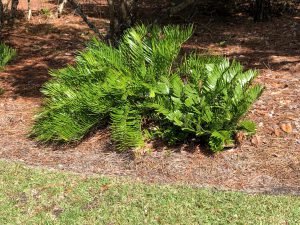
Coontie Palm in Landscape. Photo Credit: Stephen Greer, UF IFAS Extension Santa Rosa
Plants that are native and non-native are often seen in the same landscape setting. Consideration should be taken to determine if either of the groups are aggressive in expanding beyond the intended plant setting. Before moving on, non-native is in reference to plants that are introduced to a plant community that came from a totally different plant location. An example of that location being hollies from southeast Asia or South America or even a different area of the United States. Many have been researched and observed for many years under managed situations before being introduced into the local landscape nursery markets. Once in a while a plant is introduced that has not gone through a long rigorous study and can become naturalized outside of its normal plant zones and establish as an invasive species. This highly adaptable aggressive habit can, and often will colonize a given location out competing the native plants. Kudzu is a good example of an invasive exotic plant that is naturalized in the southeastern U.S.
As gardeners there are opportunities to have positive impacts on some of these diminished native habitat areas that can be threatened by growth of urban and rural areas in Florida. Establishing native plants areas into the landscape with proper soil preparation, managed water needs and more gives that chance for this interdependent system of plants, animals and nonliving elements to remain established with big impacts.
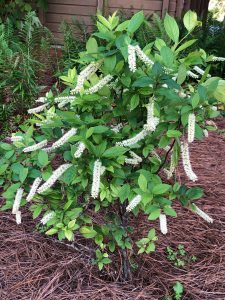
Virginia Sweetspire. Photo Credit: Stephen Greer, UF IFAS Extension Santa Rosa County
Native plants can be a working part of the garden from wonderful flowers, season color change, leaf foliage of multiple sizes and shapes to feed the insects that feed the birds, leaves and nuts that feed so many other animals for us to enjoy seeing. Balance is such a big part of being a successful gardener. Remember not all native plants are suitable for landscape spaces, do your research and ask for assistance from the experts to determine if it is the right plant for the right place.
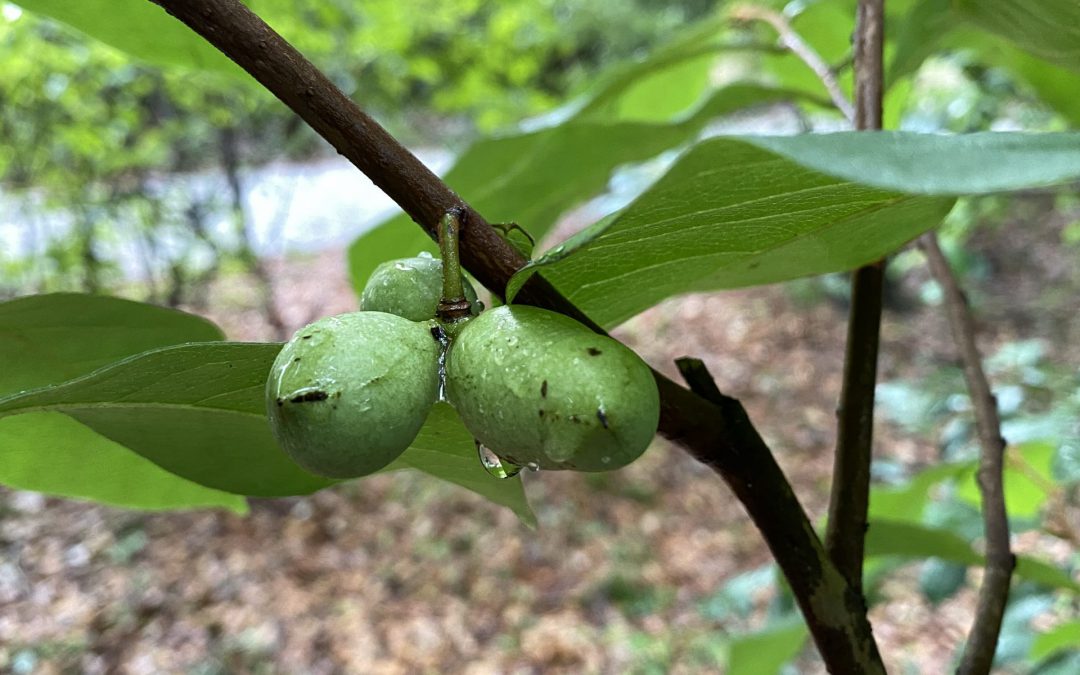
by Matt Lollar | May 20, 2020
The pawpaw (Asimina triloba) is a native edible that is often overlooked and misunderstood. Not only does it produce a delicious fruit that looks like a mango and tastes like a banana, but it is also an aesthetic landscape plant. This fruit is slowly gaining popularity with younger generations and a handful of universities (Kentucky State University and the University of Missouri) are working on cultivar improvements.
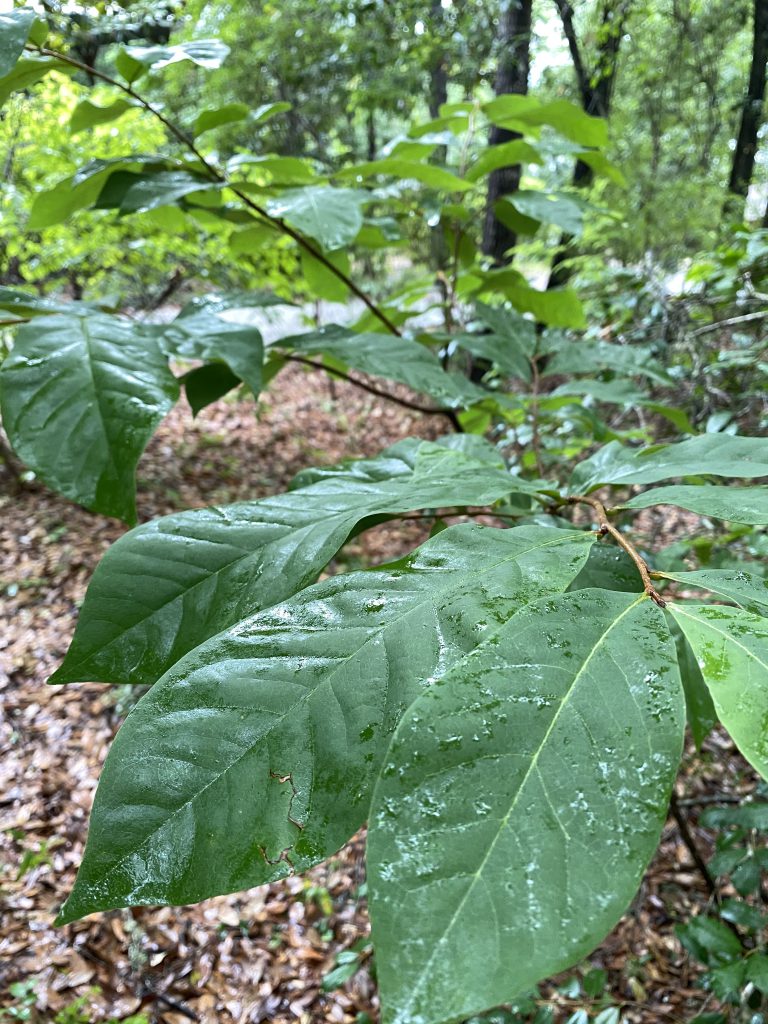
A pawpaw tree growing in the woods. Photo credit: Matt Lollar, University of Florida/IFAS Extension – Santa Rosa County
The pawpaw is native to the eastern United States (USDA Plant Hardiness Zones 5-8), however it’s closest relatives are all tropical such as the custard apple, cherimoya, and soursop. The pawpaw, along with these fruits, are known for their custard-like texture which may be a unpleasant for some consumers. Pawpaws are relatively hardy, have few insect pests, and can still produce fruit in partial shade (although they produce more fruit when grown in full sun).
Pawpaws perform best in moist, well-drained soils with a pH between 5.5 and 7.0. They are found growing wild in full to partial shade, but more fruit are produced when trees are grown in full sun. However, pawpaws need some protection from wind and adequate irrigation in orchard settings. Trees can grow to between 12 feet to 25 feet tall and should be planted at least 15 feet apart. In the Florida Panhandle, flowers bloom in early spring and fruit ripen from August to October depending on variety and weather.
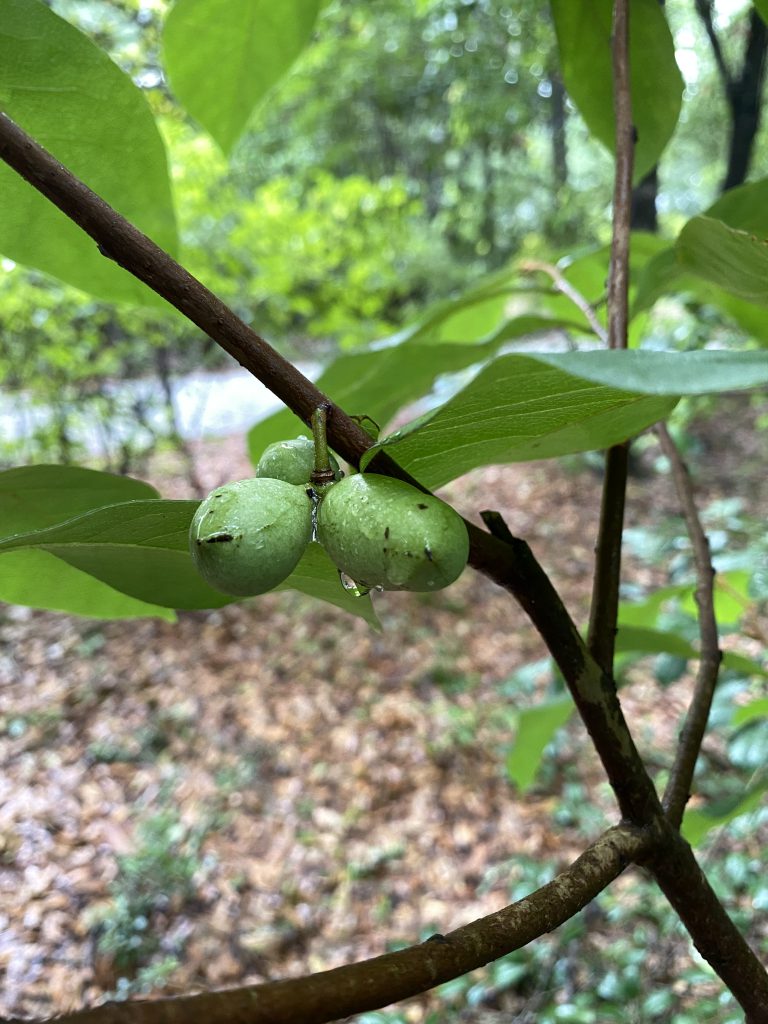
Young pawpaw fruit growing on a small tree. Photo Credit: Matt Lollar, University of Florida/IFAS Extension at Santa Rosa County
A number of improved cultivars of pawpaws have been developed that produce more fruit with more flavor than native seedlings/saplings. The University of Missouri has conducted trials on the following pawpaw cultivars: ‘Sunflower’; ‘PA Golden’; ‘Wells’; ‘NC-1’; ‘Overleese’; ‘Shenandoah’; ‘Susquehanna’; and ’10-35′. Most of these cultivars performed well in southern Missouri, however yields may differ in the Florida Panhandle. The full results of the trial can be found in the “Pawpaw – Unique Native Fruit” publication.
Pawpaws can be propagated by seed or cuttings. Unlike most fruit trees, pawpaws are usually true to seed meaning that saved seed produces a tree with similar characteristics to the parent tree. To save seeds, place fresh seeds in a bag of moist peat moss and refrigerate for 3 to 4 months before planting. To vegetatively propagate, take cuttings (pencil thin in diameter) in the winter and store in a refrigerator until early spring. Cuttings should be chip budded onto seedling rootstock during the spring. Please visit this publication from the University of Nebraska for more information on chip budding.
Pawpaw fruit are ready to harvest when they are slightly soft when gently squeezed. Fruits picked prior to being fully ripe, but after they start to soften, will ripen indoors at room temperature or in a refrigerator. Already-ripe fruit will stay fresh for a few days at room temperature or for a few weeks in the refrigerator. To enjoy pawpaw fruit throughout the year, scoop out the flesh, remove the seeds, and place the flesh in freezer bags and freeze.
Whether you want to add more native plants to your landscape or you are a rare and unusual fruit enthusiast, pawpaw may be the tree for you. They can be utilized as a focal point in the garden and provide delicious fruit for your family. For more information on pawpaw or other fruit trees, please contact your local Extension Office.
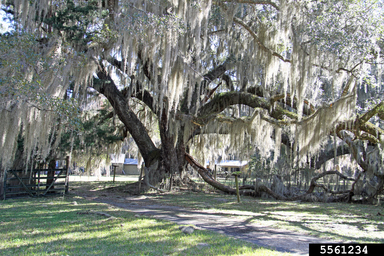
by Mark Tancig | Dec 17, 2018

Native trees, like this Live Oak (Quercus virginiana), provide habitat for various insects fed upon by birds. Source: James Holland, Bugwood.org
Planting native plants is a topic many north Florida gardeners, and subscribers to Gardening in the Panhandle, have seen covered in various ways and formats. It doesn’t take a great leap of understanding to realize that native plants are highly valued by our wildlife, which have adapted to living with these plants for millennia. However, we also get a lot of information about the latest, greatest landscape plant variety, many of which are non-native, and are lured to purchase them by their beautiful flowers and/or foliage. In the wake of Hurricane Michael, the importance of selecting native plants for the landscape becomes apparent when you look around and see whole forests severely disturbed. Furthermore, recent research has shown how much our native wildlife prefer native plants and need them for the best chances of survival.
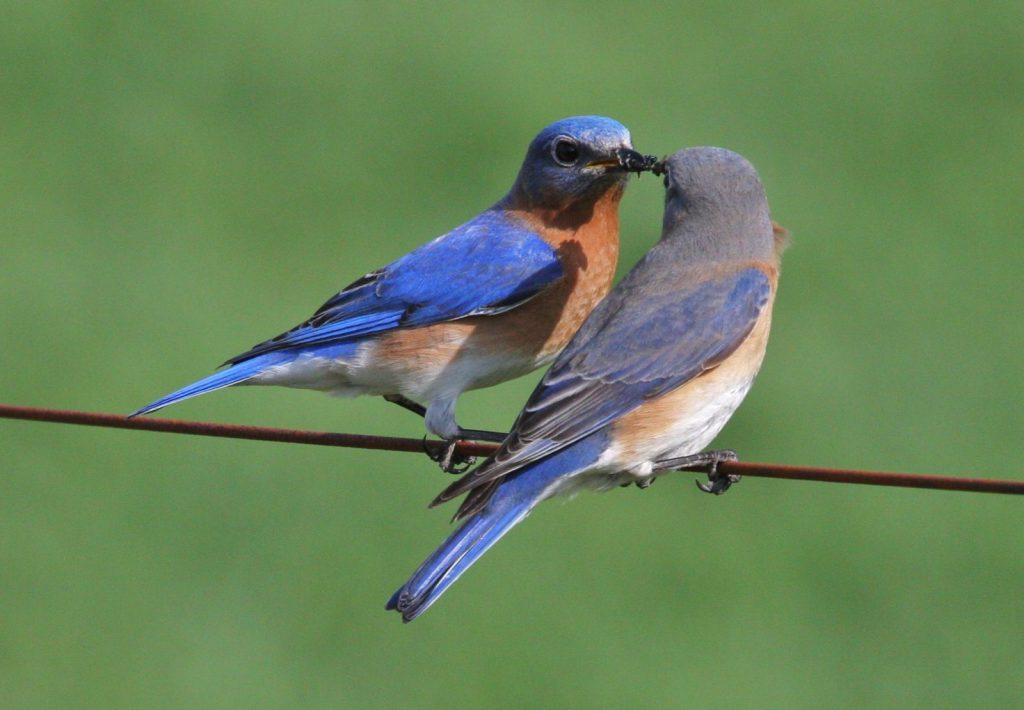
Eastern bluebirds are an example of a bird that relies on insects. Source: Sandysphotos, Creative Commons.
Why Native Plants?
It’s not that non-native ornamental plants are “bad”, unless they’re the terrible invasive, exotic species like kudzu, Chine privet, etc., it’s just that the food chains that support our wildlife are adapted to native plants. A recent report published in the National Proceedings of Science found that chickadees had far better success fledging young when they foraged landscape areas containing 70% or more native plant cover. The reason for their success was that the insects they feed on utilize native species more than non-native plant species. Does that mean non-natives provide no value? Not necessarily. Non-native ornamental plants can be important sources of nectar and pollen and, as you know from experience dealing with pest problems on non-native plants, they also support insects. Native plants just support more of an abundance of these insects.
Following a large disturbance like Hurricane Michael, many insects, birds, and other wildlife will likely see a decrease in numbers and/or reproductive success due to the loss and/or disruption of native plant ecosystems. As stated in the recent report, restoration of urban areas should prioritize native plants to support local food webs.
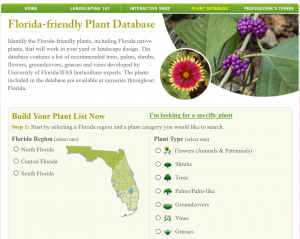
The deactivated_site website is a great resource to find native trees for your area. Source: Screenshot, deactivated_site.
The deactivated_site website is an easy way to start putting together a list of potential plants. The website’s Florida-Friendly Plant Database allows users to select the area of Florida they live in, site conditions, plant type (tree, shrub, etc.), and to specify native plants only. It then searches the database for plants that meet those conditions and creates a list of species, along with photos and care information. If you’re thinking about how these trees hold up to storms, you can cross-check that list with UF/IFAS’s Wind and Trees EDIS publication. Of course, if you have any questions along the way, please contact your local UF/IFAS Extension Office.
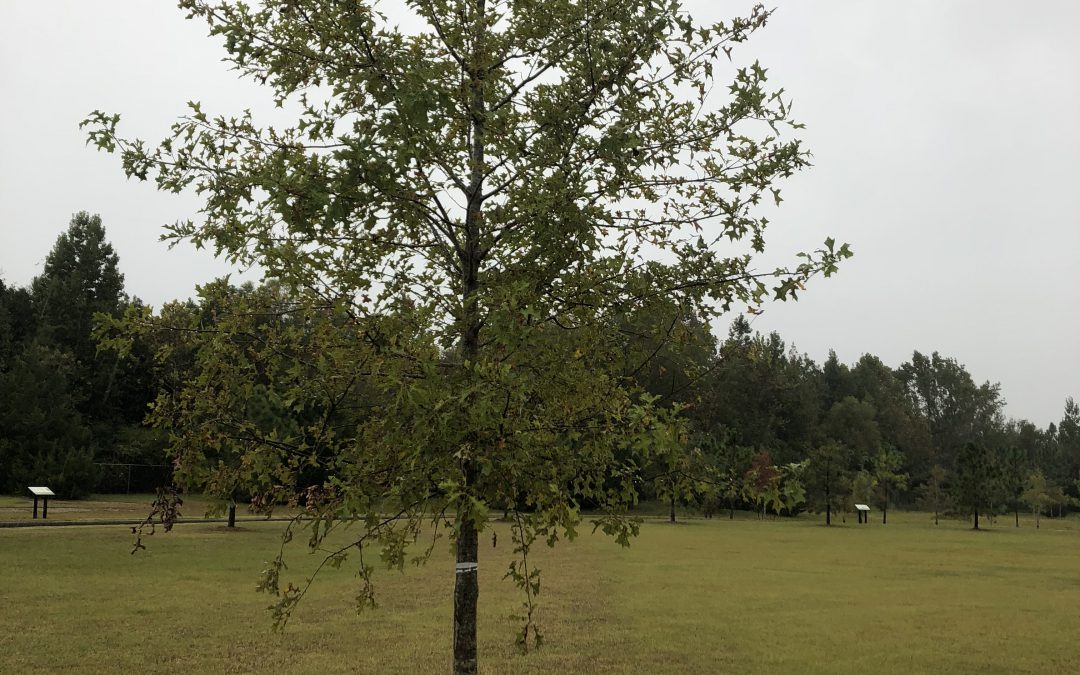
by Matt Lollar | Nov 8, 2018
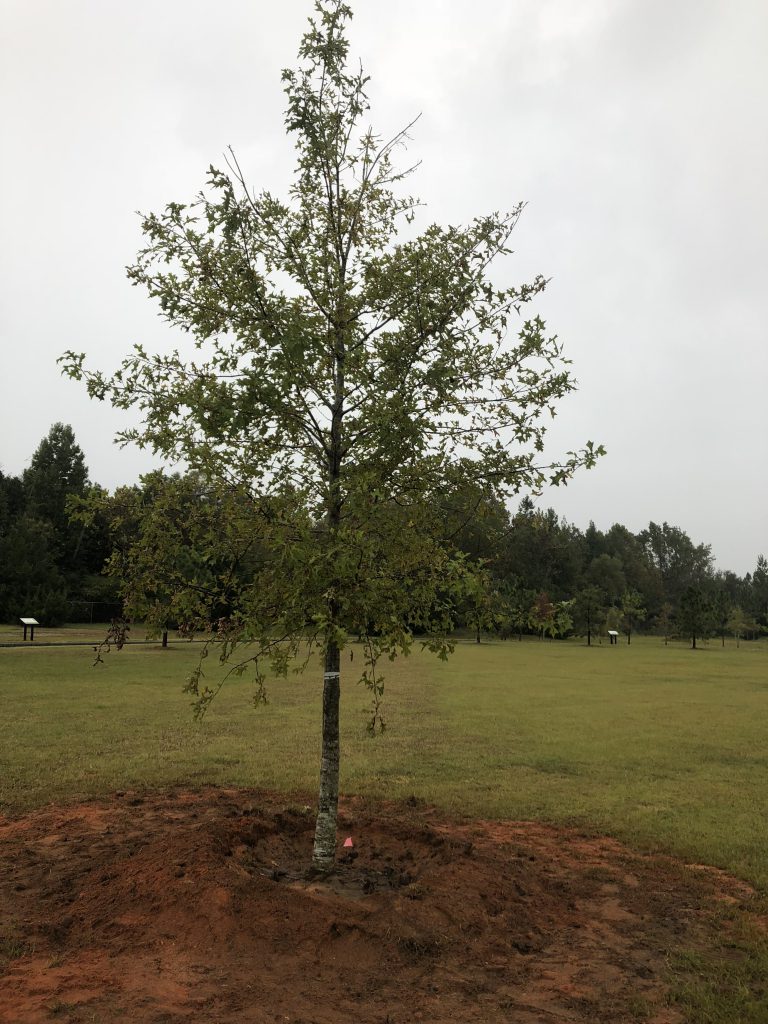
A planted tree with water retention berm. Photo Credit: Matt Lollar, University of Florida/IFAS Extension – Santa Rosa County
Often, Extension agents are tasked with evaluation of unhealthy plants in the landscape. They diagnose all sorts of plant problems including those caused by disease infection, insect infiltration, or improper culture.
When evaluating trees, one problem that often comes to the surface is improper tree installation. Although poorly installed trees may survive for 10 or 15 years after planting, they rarely thrive and often experience a slow death.
Fall is an excellent time to plant a tree in Florida. A couple of weeks ago beautiful Nuttal Oak was planted at Bagdad Mill Site Park in Santa Rosa County, FL. Here are 11 easy steps to follow for proper tree installation:
- Look around and up for wire, light poles, and buildings that may interfere with growth;
- Dig a shallow planting hole as wide as possible;
- Find the point where the top-most root emerges from the trunk;
- Slide the tree carefully into the planting hole;
- Position the point where the top-most root emerges from the trunk slightly above the landscape soil surface;
- Straighten the tree in the hole;
- Remove synthetic materials from around trunk and root ball;
- Slice a shovel down in to the back fill;
- Cover the exposed sides of the root ball with mulch and create water retention berm;
- Stake the tree if necessary;
- Come back to remove hardware.
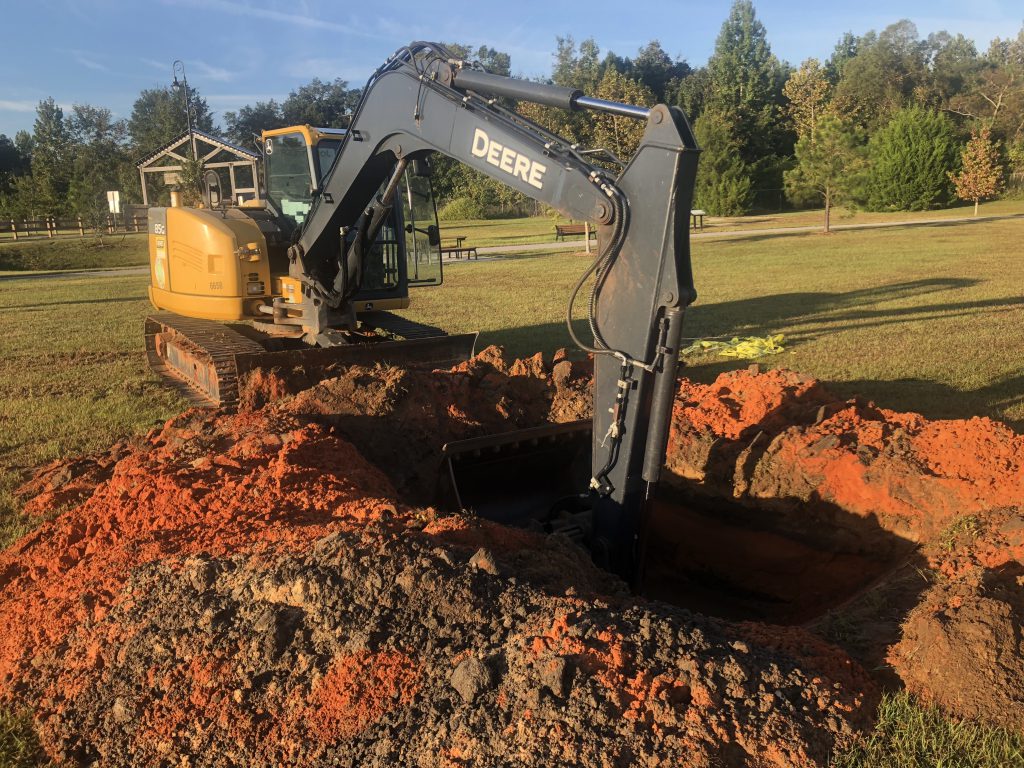
Digging a properly sized hole for planting a tree. Photo Credit: Matt Lollar, University of Florida/IFAS Extension – Santa Rosa County
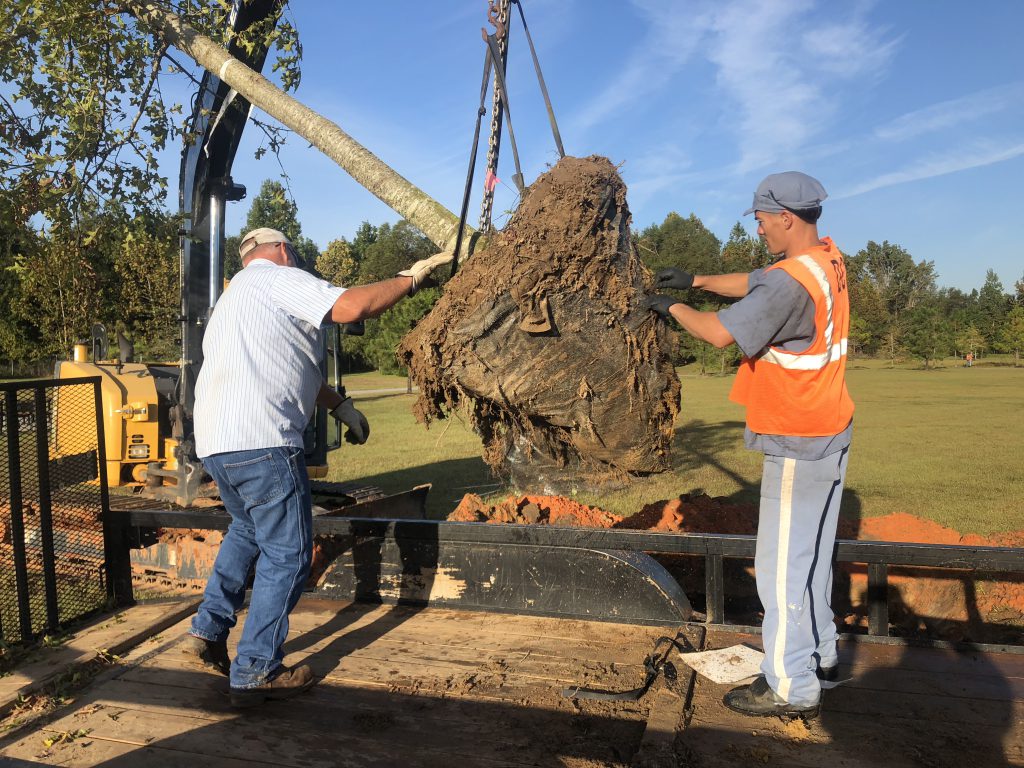
Removing synthetic material from the root ball. Photo Credit: Matt Lollar, University of Florida/IFAS Extension – Santa Rosa County
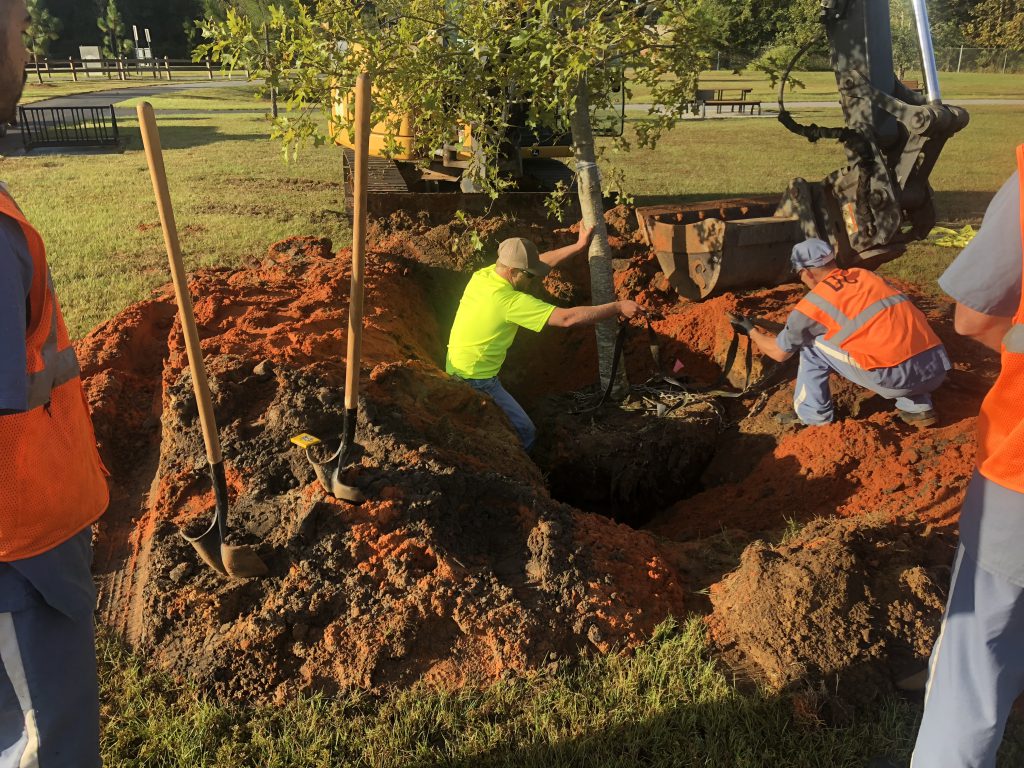
Straightening a tree and adjusting planting height. Photo Credit: Matt Lollar, University of Florida – Santa Rosa County
For more detailed information on planting trees and shrubs visit this UF/IFAS Website – “Steps to Planting a Tree”.
For more information Nuttall Oaks visit this University of Arkansas Website.
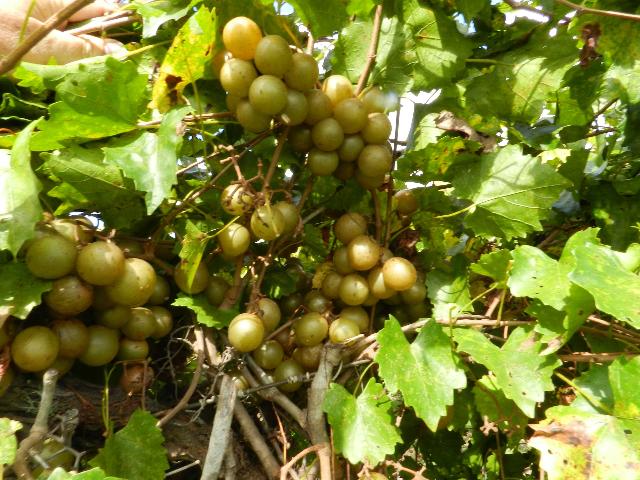
by Mark Tancig | Sep 6, 2018
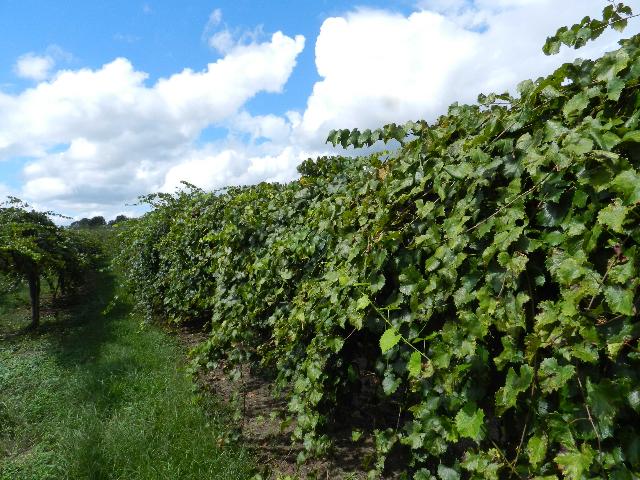
A grape vineyard. Credit: Peter Andersen, UF/IFAS.
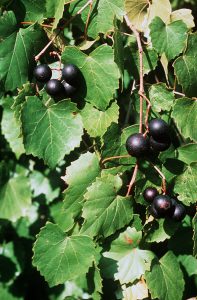
The classic muscadine (Vitis rotundifolia). Credit: Carl Hunter. USDA-PLANTS Database.
This is the time of year to be on the watch for purple-stained sidewalks and driveways – a sign that ripe muscadine grapes are falling from above. The muscadine grape (Vitis rotundifolia) is a native Florida vine that has been enjoyed by Native Americans, colonists, and contemporary Floridians alike. In addition to the classic muscadine and scuppernong, a light-colored variety of muscadine, there are five other native species of grape (Vitis spp.) to be found growing in natural areas or along woodland edges. All are edible, however, the muscadine has the largest, tastiest fruit.
Many north Florida gardeners have some species of grape growing in their landscapes and consider it a weed due to its aggressive growth. Unfortunately, since the vines are functionally dioecious (separate male and female plants) and most wild plants are male, it is unlikely that those annoying grapevines at the garden’s edge will ever bear fruit. But every now and again, luck strikes! That’s why finding a purple-stained sidewalk or parking area is such an exciting event. I have some of these locations saved in my memory to visit this time of year, especially since all the grapevines in my own property have yet to bear one fruit! If necessary, control methods for grapevine in a landscape include repeated pruning back or the use of herbicides. Muscadines and other grapes are intolerant of shade so will eventually perish if cut back and located under a canopy of trees or shrubs.
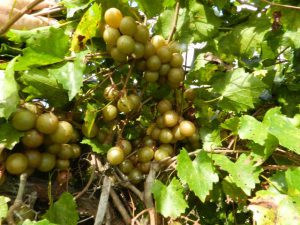
The bronze-colored scuppernong. Credit: Peter Andersen. UF/IFAS.
Good News! There are plenty of varieties bred for the backyard and commercial fruit grower. Since muscadines are native, they require little, if any, pesticides, making them a great choice for a sustainable landscape or orchard. The vines can be grown up an arbor or a complete vineyard trellis system can be built for maximum harvest. A UF/IFAS fact sheet called “The Muscadine Grape” (publication #HS763) contains all the information needed to choose the right variety, design a vineyard, and implement the best pruning, irrigation, and fertilization schedule.
Whether fresh off the vine or in jams or wine, muscadines are a sweet, summery treat for Floridians.



















